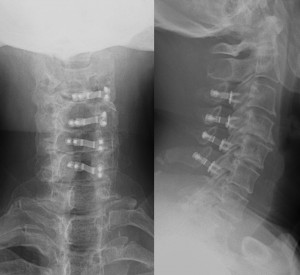Newest Surgical Options for Cervical Spine Degeneration
Cervical degenerative disc disease is a common problem associated with aging. Though the lumbar, or lower region, is the region of the spine most commonly associated with degenerative changes, due to the greater stresses placed on the lower back, the neck, or cervical spine, is also prone to degenerative weakening. Fortunately, advances in procedures for degenerative cervical disc disease surgery has created new options for treating this common problem. Of course surgery should be pursued only following the exhaustion of all appropriate non-surgical therapeutic modalities.
Disc arthroplasty is one major advance in treating cervical spine degeneration therapy. Arthroplasty is a procedure in which a prosthetic, or artificial disc, is implanted to replace a compromised spinal disc. It is an alternative to shoring up the degenerated disc with bone grafts, plates and screws in conventional cervical disc surgery. Disc arthroplasty has the benefit of preserving normal range of motion of the vertebrae, unlike surgery involving bone fusion.
Cervical laminoplasty, another advanced procedure, is used to relieve spinal compression, or pressure on nerves in or emanating from the spinal canal, without removing the lamina, or spinous processes. There are several variations of this procedure, which preserves more of the vertebrae than is possible with a laminectomy, the standard surgical procedure for spinal decompression surgery.
Advanced minimally invasive surgery techniques performed on the cervical spine include endoscopic posterior cervical lamino-foraminotomy and anterior cervical foraminotomy. These endoscopic surgeries are performed through very small incisions, utilizing muscle splitting techniques that cause less tissue damage and result in faster recoveries with fewer complications. Even the techniques by which these operations are performed, such as the posterior approach and the anterior approach, are also rapidly evolving, leading to better surgical outcomes and recoveries.
Further Considerations
Whatever form of surgery you are considering, your surgeon should discuss the operation, the risks and benefits, outcomes, potential complications and alternative treatments thoroughly with you. Make sure you work with an orthopedic spine surgeon who has training and experience in advanced procedures, to ensure you have the widest spectrum of treatment options available.







